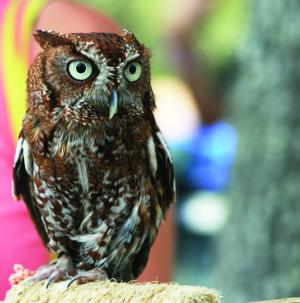Signs of spring appear in state wildlife areas
During the first two weeks of March, in order to prepare for bird nesting season, more than 350 nesting boxes at state wildlife areas throughout Delaware are getting their annual spring cleaning by Department of Natural Resources and Environmental Control Division of Fish and Wildlife staff.
Perched high on predator-proof poles at heights from six to 30 feet above the ground or water in forested wetlands, these boxes are designed primarily for wood ducks, but also can provide perfect nesting and roosting places for screech owls.
Screech owls are tiny red or gray raptors, about the size of an adult human hand. These nocturnal creatures help keep nature in balance by feeding on small mammals such as mice, insects, birds, amphibians such as salamanders and frogs, and sometimes fish. The owls seldom build their own nests, preferring instead to adopt woodpecker holes or natural cavities in large trees.
Screech owls also use manufactured nesting boxes, including wood duck boxes and boxes designed especially for them. Nest predators include raccoons, cats, great horned owls and tree-climbing black rat snakes. Human activities also can interfere with their nesting cycle.
“For many years, we have been helping to provide screech owls with safe nesting and roosting areas,” said Kent County Regional Wildlife Manager Wayne Lehman, DNREC Division of Fish and Wildlife. “The annual winter cleaning provides us with the opportunity to band roosting owls and record important data that’s used to help assess the overall health of the species. Throughout the year, we encourage the public not to open the boxes, because owls will abandon their nests if disturbed by humans.”
DNREC’s screech owl banding program was initiated in 1993 to provide Delaware scientists with information on the owls’ lifespan, home range, habitat preferences, nest box loyalty and migration patterns. The banding serves as a key research tool to access impacts to the species caused by the loss of their natural habitat through increases in land development.
Although the average lifespan of screech owls is approximately one year, Lehman said, Delaware biologists have recaptured a few birds that were originally banded 12 years prior to the most recent recapture date. Captures have shown that the owls have relatively small home ranges, averaging approximately 3 acres. The owls tend to have high nest box loyalty, and many individuals have been found in the same boxes year after year.
Eastern screech owls prefer forests and treelines that provide both nesting cavities and adjacent foraging habitat - usually open areas where mice and other small rodents live. Typically, these owls also prefer areas with cover such as a moderately dense shrub layer to provide foraging perches and roosting habitat when not using cavities.
Screech owls and wood ducks can use separate wood duck boxes in the same area, if the boxes are placed in or near appropriate habitat. However, wood ducks face competition and eviction from the boxes by a non-native, invasive species, European starlings, though this can be minimized through proper box placement.
“Starlings are aggressive in taking over suitable nesting cavities and preventing native species from using them. However, placement of the nesting boxes can tip the scales in favor of the native species,” Lehman said. “Starlings prefer to nest in open habitat, whereas both screech owls and wood ducks like nesting in wooded areas. We’ve placed the nesting boxes shared by screech owls and wood ducks primarily in wooded habitat, where the boxes don’t attract starlings.”
DNREC’s conservation efforts to protect screech owls and other native species is one of several initiatives of Delaware’s Natural Heritage and Endangered Species Program, as well as Delaware’s Wildlife Action Plan, which outlines a comprehensive strategy for conserving the full array of native wildlife and habitats in the state.
Plastic wood duck boxes are available to the public for purchase for $30 through the Division of Fish and Wildlife’s regional wildlife offices in each county. For more information in Kent County, call 302-284-1077; in Sussex County, call 302-539-3160.
For more information on banding screech owls and barn owls, contact Wayne Lehman, Division of Fish and Wildlife, at 302-284-1077.
























































